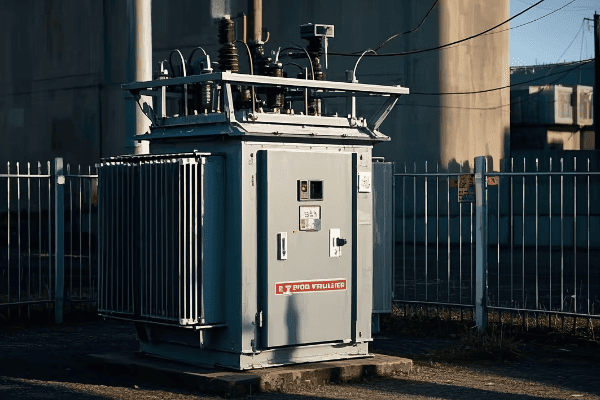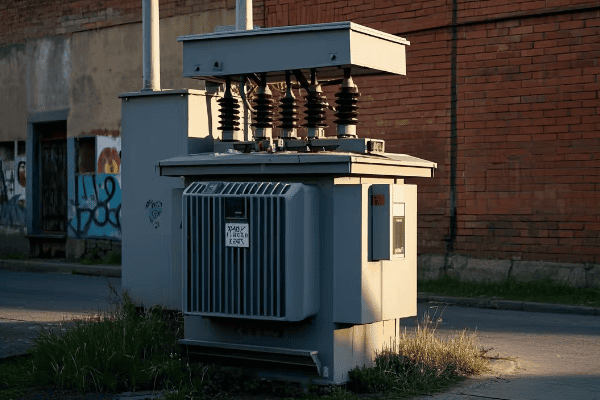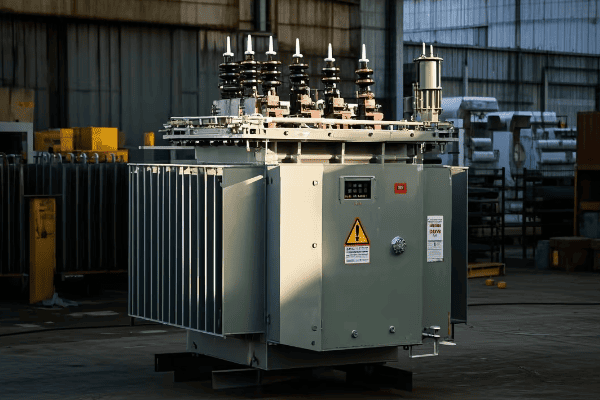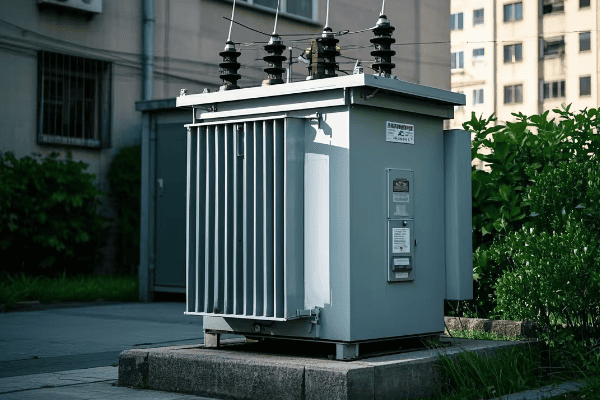What Is a Electric Transformer: The Vital Link in Modern Power Systems?
Have you ever wondered how electricity travels safely from power plants to your home? The answer lies in a device you rarely see but heavily rely on: the electric transformer.
An electric transformer is a device that changes the voltage of electrical power. It allows electricity to be transmitted efficiently over long distances and then safely used in our homes and businesses. Transformers are the vital link that makes our modern power systems possible.

As an electrical engineer with years of experience in the power industry, I’ve seen firsthand how crucial these devices are. Let’s explore the world of electric transformers and discover why they’re so important for our modern life.
The Crucial Connection: How Electric Transformers Bridge Power Generation and Consumption?
Imagine trying to pour water from a fire hose into a drinking glass. That’s similar to the challenge of getting electricity from power plants to your home. Transformers are the solution to this problem.
Electric transformers bridge power generation and consumption by changing voltage levels. They increase voltage at power plants for efficient long-distance transmission, then decrease it in stages for safe local distribution and use. This process ensures power reaches consumers efficiently and safely.

Let’s dive deeper into how transformers connect power generation to consumption:
Step-Up Transformers at Power Plants
The journey begins at the power plant:
- Generators produce electricity at relatively low voltages (10,000 to 25,000 volts).
- Step-up transformers increase this voltage to 100,000 to 1,000,000 volts.
- This high voltage is crucial for efficient long-distance transmission.
Transmission Transformers
As power moves through the grid:
- Transmission transformers adjust voltages between different transmission line levels.
- They help manage power flow across the transmission network.
- These transformers are often equipped with cooling systems for high efficiency.
Distribution Transformers
As electricity nears its destination:
- Distribution transformers reduce voltage from transmission levels to medium voltage (typically 4,000 to 35,000 volts).
- These are found in local substations and neighborhoods.
- They prepare power for final delivery to consumers.
Final Step-Down Transformers
The last stage before reaching homes and businesses:
- Pole-mounted or pad-mounted transformers reduce voltage to 120/240 volts.
- This is the final step that makes electricity safe for household use.
- These transformers are designed for reliability and low maintenance.
Here’s a simplified view of voltage changes in power transmission:
| Location | Transformer Type | Input Voltage | Output Voltage |
|---|---|---|---|
| Power Plant | Step-Up | 25,000 V | 765,000 V |
| Transmission Substation | Transmission | 765,000 V | 230,000 V |
| Distribution Substation | Distribution | 230,000 V | 13,800 V |
| Neighborhood | Final Step-Down | 13,800 V | 120/240 V |
I once worked on a project to upgrade a city’s power infrastructure. We replaced transformers at each stage of this journey. The improvement in efficiency was remarkable. We could deliver more power with fewer losses, and voltage stability at the consumer end improved significantly. It was a clear demonstration of how crucial transformers are in bridging the gap between power generation and consumption.
Transformers are the unsung heroes of our power systems. They make it possible to generate electricity in large, efficient power plants and deliver it to millions of homes and businesses across vast distances. Without them, our modern electrical grid simply wouldn’t be possible. Every time you turn on a light or charge your phone, you’re benefiting from this invisible but vital link in our power systems.
Anatomy of a Power System Linchpin: Key Components and Types of Electric Transformers?
Have you ever opened up a device to see how it works? While I don’t recommend doing this with a transformer, understanding its components is key to grasping its function in our power systems.
Electric transformers consist of several key components: the core, windings, insulation, and cooling system. These parts work together to change voltage levels efficiently. Different types of transformers, from massive power transformers to small distribution units, are designed for specific roles in the power system.

Let’s break down the anatomy of a transformer and explore its various types:
Key Components of a Transformer
-
Core:
- Made of thin layers of silicon steel (laminations).
- Provides a path for the magnetic field.
- Laminations reduce energy losses from eddy currents.
-
Windings:
- Primary winding: Receives input power.
- Secondary winding: Delivers output power.
- The ratio of turns determines the voltage change.
-
Insulation:
- Prevents short circuits between windings and core.
- Materials include paper, oil, and resin.
-
Cooling System:
- Manages heat generated during operation.
- Can be air-cooled, oil-cooled, or use other methods.
Types of Transformers
-
Power Transformers:
- Used in power plants and major substations.
- Handle very high voltages and large power capacities.
- Often equipped with advanced cooling and monitoring systems.
-
Distribution Transformers:
- Found in neighborhoods and on utility poles.
- Reduce voltage to levels safe for homes and businesses.
- Designed for reliability and low maintenance.
-
Instrument Transformers:
- Include current transformers (CTs) and voltage transformers (VTs).
- Used for measurement and protection in power systems.
- Provide inputs for meters, relays, and other instruments.
-
Special-Purpose Transformers:
- Isolation transformers: Provide electrical isolation for safety.
- Autotransformers: Used for small voltage adjustments.
- Phase-shifting transformers: Control power flow in transmission systems.
Here’s a comparison of different transformer types:
| Type | Size | Voltage Range | Primary Use |
|---|---|---|---|
| Power | Very Large | 100kV – 1000kV+ | Transmission substations |
| Distribution | Small to Medium | 4kV – 35kV | Local power distribution |
| Instrument | Very Small | Varies | Measurement and protection |
| Special-Purpose | Varies | Varies | Specific applications |
I remember the first time I opened up a distribution transformer during a training session. The precision of each component was impressive. The tightly wound coils, the carefully stacked core laminations, and the intricate insulation system all worked together in perfect harmony. It gave me a new appreciation for the engineering that goes into these devices we often take for granted.
Understanding the anatomy and types of transformers is crucial for anyone working in the power industry. Each component plays a vital role, and different transformer types are optimized for specific functions in our power systems. From the massive power transformers at substations to the small distribution units in our neighborhoods, each is a marvel of engineering designed to keep our power flowing reliably and efficiently.
Guardians of the Grid: Transformers’ Role in Ensuring Power Stability and Reliability?
Have you ever experienced a power outage and wondered why it doesn’t happen more often? The answer lies in the silent work of transformers, the true guardians of our power grid.
Transformers play a crucial role in ensuring power stability and reliability. They regulate voltage levels, manage power flow, and help isolate faults in the grid. Advanced transformers can even adapt to changing load conditions, helping to prevent outages and maintain consistent power quality.

Let’s explore how transformers protect and stabilize our power systems:
Voltage Regulation
Transformers help maintain stable voltage levels:
-
On-Load Tap Changers (OLTC):
- Allow transformers to adjust their voltage ratio while operating.
- Compensate for voltage fluctuations in real-time.
- Ensure consumers receive power within acceptable voltage ranges.
-
Voltage Support:
- Some transformers can provide reactive power compensation.
- This helps maintain voltage stability, especially in long transmission lines.
Fault Isolation
Transformers play a key role in protecting the grid from faults:
-
Impedance Barrier:
- Transformer impedance limits fault currents.
- This helps contain faults and prevent them from spreading through the grid.
-
Differential Protection:
- Advanced transformers use differential relays.
- These can quickly detect and isolate internal faults.
Power Flow Management
Transformers help balance power flow in the grid:
-
Phase-Shifting Transformers:
- Control the direction of power flow in parallel transmission paths.
- Help optimize grid loading and prevent overloads.
-
HVDC Converter Transformers:
- Enable interconnection of asynchronous grids.
- Allow for more flexible power exchange between regions.
Here’s a table summarizing transformer features that enhance grid stability:
| Feature | Function | Benefit to Grid Stability |
|---|---|---|
| OLTC | Adjusts voltage ratio | Maintains stable voltage levels |
| Impedance | Limits fault currents | Contains faults, prevents widespread outages |
| Phase-Shifting | Controls power flow direction | Optimizes grid loading, prevents overloads |
| HVDC Conversion | Enables DC transmission | Allows long-distance power transfer, grid interconnection |
I once worked on a project to upgrade a critical substation that served a large industrial area. We installed new transformers with advanced OLTCs and digital monitoring systems. The improvement in power quality was remarkable. Voltage fluctuations decreased by 50%, and the system could respond to load changes much faster. Even during a severe thunderstorm, when part of the grid was damaged, these transformers helped isolate the fault and reroute power, preventing a widespread blackout.
Transformers are more than just voltage converters; they’re active guardians of our power grid. Their ability to regulate voltage, manage power flow, and isolate faults is crucial for maintaining the stability and reliability of our electrical systems. As our grid becomes more complex with the integration of renewable energy sources and increasing power demands, the role of transformers in ensuring a stable and reliable power supply becomes even more critical. They’re the unsung heroes working 24/7 to keep our lights on and our modern world running smoothly.
Transformers and Green Energy: Enabling the Integration of Renewable Power Sources?
Have you ever wondered how the energy from solar panels or wind turbines makes it to your home? The answer involves a special role for our friends, the transformers.
Transformers are crucial in integrating renewable energy sources into our power grids. They handle the variable output of renewables, enable long-distance transmission from remote generation sites, and help maintain grid stability. Modern transformers are evolving to meet the unique challenges of green energy integration.

Let’s explore how transformers are powering the green energy revolution:
Handling Variable Output
Renewable sources like wind and solar have variable output. Transformers help manage this:
-
Advanced Voltage Regulation:
- Use of on-load tap changers (OLTCs) to adjust voltage in real-time.
- Helps maintain stable grid voltage despite fluctuating renewable input.
-
Wide Range Operation:
- Transformers designed to operate efficiently across varying loads.
- Crucial for solar installations where output varies throughout the day.
Enabling Long-Distance Transmission
Many renewable sources are far from population centers:
-
HVDC Converter Transformers:
- Enable efficient long-distance transmission from offshore wind farms or remote solar installations.
- Allow power transfer between asynchronous grids, important for large-scale renewable integration.
-
Step-Up Transformers:
- Increase voltage from renewable generation sites for efficient transmission.
- Often designed for harsh environments (e.g., offshore wind farms).
Grid Stability and Power Quality
Transformers help maintain grid stability with high renewable penetration:
-
Harmonic Mitigation:
- Special designs to handle harmonics introduced by renewable energy inverters.
- Helps maintain power quality across the grid.
-
Reactive Power Compensation:
- Some advanced transformers can provide reactive power support.
- Helps stabilize voltage, especially important with variable renewable sources.
Here’s a comparison of transformer applications in conventional and renewable energy systems:
| Aspect | Conventional Power | Renewable Energy |
|---|---|---|
| Power Flow | Mostly one-way | Often bidirectional |
| Output Stability | Relatively stable | Highly variable |
| Harmonics | Limited | Significant (due to inverters) |
| Location | Near population centers | Often in remote areas |
| Voltage Levels | Standardized | May vary widely |
I recently worked on a project integrating a large offshore wind farm into the grid. The challenges were significant. We needed transformers that could handle the variable output, cope with the harsh marine environment, and efficiently transmit power over long distances. The solution involved advanced transformers with dynamic voltage regulation and HVDC technology. It was a complex project, but it showed me the incredible potential of transformers in enabling our renewable energy future.
Transformers are not just adapting to the renewable revolution; they’re enabling it. They’re the bridge between green energy sources and our existing power infrastructure. As we continue to increase our reliance on renewable sources, the role of these adaptable and resilient transformers will only grow in importance. From handling variable outputs to enabling long-distance transmission and maintaining grid stability, transformers are key to building a greener, more sustainable energy future.
Smart Transformation: The Evolution of Electric Transformers in the Digital Age?
Remember when phones were just for calling? Now they’re smart devices that do almost everything. The same revolution is happening with transformers, and it’s changing our power grid.
Electric transformers are evolving in the digital age, becoming smarter and more connected. Modern transformers incorporate sensors, communication capabilities, and advanced analytics. This allows for real-time monitoring, predictive maintenance, and more efficient grid management, paving the way for smarter, more reliable power systems.

Let’s explore how transformers are getting smarter:
Real-Time Monitoring and Diagnostics
Smart transformers are always on watch:
-
Integrated Sensors:
- Monitor key parameters like temperature, oil condition, and load.
- Provide real-time data on transformer health and performance.
-
Advanced Analytics:
- Use artificial intelligence to analyze sensor data.
- Can predict potential issues before they cause failures.
Communication and Grid Integration
Smart transformers are becoming part of the Internet of Things (IoT):
-
Two-Way Communication:
- Can send data to control centers and receive commands.
- Enables better coordination with other grid components.
-
Grid Optimization:
- Help balance loads and manage power flow more efficiently.
- Can adapt to changing grid conditions in real-time.
Enhanced Efficiency and Reliability
Smart features lead to better performance:
-
Dynamic Load Management:
- Adjust operation based on current load conditions.
- Optimize efficiency across varying demand.
-
Predictive Maintenance:
- Schedule maintenance based on actual condition, not just time intervals.
- Reduce downtime and extend transformer life.
Renewable Energy Integration
Smart transformers are crucial for green energy:
-
Bidirectional Power Flow:
- Handle power flowing both to and from the grid.
- Essential for integrating distributed renewable sources.
-
Power Quality Management:
- Actively manage issues like harmonics from renewable inverters.
- Maintain stable power quality with variable renewable inputs.
Here’s a comparison of traditional and smart transformer features:
| Feature | Traditional Transformer | Smart Transformer |
|---|---|---|
| Monitoring | Basic gauges | Real-time digital monitoring |
| Communication | None or minimal | Two-way with grid systems |
| Maintenance | Time-based | Condition-based predictive |
| Efficiency | Fixed design | Dynamically optimized |
| Renewable Integration | Limited capability | Advanced features for renewables |
I recently visited a newly upgraded substation that showcased these smart transformers. The difference was striking. The new units had touchscreen interfaces displaying real-time data. The substation operator showed me how they could adjust settings remotely and even predict potential issues weeks in advance. During my visit, the system detected a minor anomaly in one transformer and automatically adjusted loads to compensate, preventing any disruption in service. It was like watching the future of power distribution unfold before my eyes.
The evolution of transformers into smart, connected devices is more than just a technological upgrade. It’s a fundamental shift in how we manage and interact with our power distribution systems. These smart transformers are enablingmore efficient, reliable, and flexible power grids. They’re not just reacting to changes; they’re anticipating and adapting to them in real-time.
As we move towards a more distributed, renewable-based, and digitally-driven energy future, smart transformers will play a crucial role. They’ll help us integrate more renewable sources, respond faster to changing demand patterns, and maintain a stable and reliable power supply in an increasingly complex grid environment.
The transformation of these devices from passive components to active, intelligent nodes in our power network is a key step in the evolution of our energy infrastructure. It’s an exciting time to be in the power industry, as we witness and participate in this smart transformation that’s shaping the future of electricity distribution.
Conclusion
Electric transformers are the vital link in modern power systems, bridging generation and consumption, ensuring stability and reliability, enabling renewable integration, and evolving with smart technologies. They are crucial in shaping an efficient, reliable, and sustainable energy future.
Free CHBEB Transformer Catalog Download
Get the full range of CHBEB transformers in one catalog.
Includes oil-immersed, dry-type, pad-mounted, and custom solutions.
Quick Message
Request A free quote
We'd like to work with you
- +86 15558785111
- [email protected]
- +86 15558785111
What We Do
CHINA BEI ER BIAN (CHBEB) GROUP, with 218 million in registered capital, originated from Beijing Beierbian Transformer Group. Headquartered in Beijing for R&D, it operates major production bases in Nanjing and Yueqing, producing high-quality products.
Latest Product
address
BeiJing
No 3,RongJing East Road,BeiJing Economic Technological Development Area,BeiJing,China
JiangSu
No 7️Xiangfeng Road,Jiangning,NanJing,JiangSu,China
WenZhou
No.211, Wei 16 Road, Industrial Zone, Yueqing, Wenzhou, Zhejiang, China.
XiangYang Industrial Zone ,YueQing,WenZhou,ZheJiang,China
contact us
- [email protected]
- +86 13057780111
- +86 13057780111
- +86 15558785111
Copyright © Bei Er Bian Group


